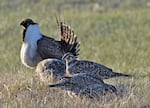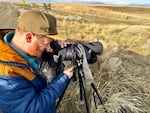
FILE - In this March 1, 2010 file photo, from the U.S. Fish and Wildlife Service, a bi-state sage grouse, rear, struts for a female at a lek, or mating ground, near Bridgeport, Calif. Audubon Washington's Seth Hulett searches Horse Heaven Hills for greater sage grouse, last seen in 2018, aiming to secure ecosystem funding despite challenging detection.
Jeannie Stafford / AP
In south-central Washington’s patchwork of sagebrush and agricultural fields, one man is spending his early, early mornings searching for sage grouse. If he finds the quirky birds — that could mean more funding for the ecosystem. But the task isn’t easy.
It’s been years since anyone has officially seen the chicken-sized greater sage grouse at their mating grounds — known as leks — in Horse Heaven Hills.
“(The year of) 2018 was the last time we documented any male grouse on that lek. So at that point, the state thought these birds were gone,” said Seth Hulett, Audubon Washington’s senior program manager of the Columbia Plateau. That includes land in Washington, Oregon and Idaho.
Sage grouse were extirpated from this area in the 1960s. In the early 2000s, the Yakama Nation brought birds in — mostly from Nevada, and a few from Idaho and Wyoming. Eventually, they flew off tribal lands and onto private ones, Hulett said.
Related: Oregon delays sage grouse habitat maps for Grant County after community backlash
Since 2018, there have been rumors.
“Like, the conservation district that saw (a sage grouse) a couple years ago. He’s like, ‘Oh yeah, I was parked here, and he just walked right by.’ And I’m over here spending hours and hours, and I don’t see any. It’s just luck,” Hulett said, laughing.
People just don’t know to report sightings, he said.
“They’re a beautiful bird. The coloration on them. I love sage grouse so much, I actually have a sage grouse tattoo,” Hulett said.

Seth Hulett, Audubon Washington’s senior program manager of the Columbia Plateau, searches through his spotting scope for sage grouse.
Courtney Flatt / NWPB
The male birds have chocolate brown, spiky turkey-like tail feathers that are spread out in a fan. And a shawl of white feathers that’s reminiscent of Cruella de Vil’s fluffy coat. They also have air sacs that inflate when they do their mating call.
However, Hulett is banking on those birdie rumors, hoping to spot any number of sage grouse on mating grounds in the area — where the birds’ funky dancing and calls are on full display.
“Their little dance they do with their air sac. Inflating it. Throwing it up and down to make their very unique call. You don’t see it anywhere else in nature,” Hulett said.
A needle in the sagebrush
On this early pre-dawn morning, Hulett drove around in winding roads, occasionally pulling over to the side and to get out binoculars, scanning the hillsides. His ears were perked up, as he listened for that unmistakable male sage grouse call.
“ When it comes to lekking, they like an open hillside where they can be very showy, where their call can travel so that the females can hear and see those males up there,” he said.
It’s a chicken-sized needle in a 400-square-mile haystack. That’s the area Hulett is searching for birds in these hills.
“They’re a beautiful bird,” he said. “The coloration on them. I love sage grouse so much, I actually have a sage grouse tattoo.”
Related: Feds say new investments in Oregon sage grouse habitat paying off, but conservationists disagree
Known as an indicator species, the presence of sage grouse shows the health of the sagebrush ecosystem. If the birds are happy, healthy and there, the surrounding land is good for many, many other species, like burrowing owls or pygmy rabbits.
“On top of that healthy shrubsteppe habitat is a carbon sink,” Hulett said. “So, we’re actually fighting climate change by keeping our healthy shrubsteppe habitat intact.”
And these birds need a lot of land. They use different areas for mating, for nesting and for surviving the winter.
That’s why they’ve had a lot of trouble across the West. Bird lovers call it a death by a thousand cuts.
“ They’re facing a lot of threats, from habitat loss due to fire, annual grass invasion. We have lots of developments going in that are just taking out habitat,” Hulett said.
In Washington, sage grouse face even more habitat fragmentation than other main sage grouse populations. They’re cut off from many of the other birds in Oregon and Idaho.
If Hulett finds any sage grouse, he said that could open up more funding to help this ecosystem — and the private landowners who steward it. That’s money for habitat restoration, grazing management and water quality, he said.
“ We should be using sage grouse as our mascot for shrubsteppe. If you have a sage grouse on your land, let’s use that. Let’s tell people,” Hulett said.
He said that funding — from the state, the feds or nonprofits — can help fix or maintain good habitat for landowners and for birds.

A foggy view of the historic lek where sage grouse were last seen in 2018.
Courtney Flatt / NWPB
Sage grouse struggle to recover
His search is funded through a grant from the Washington Department of Fish and Wildlife. Sage grouse are considered endangered in the state. They now occupy around 8% of their historic range in Washington, according to the department.
In 2015, the federal government decided not to add the birds to its endangered species list. This hard-fought conservation movement was supported by ranchers, biologists and conservation groups across 11 western states.
Last year, biologists estimated 777 sage grouse in Washington. Counts were up about 50% from 2023, which was about 429 birds, said Michael Schroeder, who’s been working on the sage grouse issue with the state Department of Fish and Wildlife for decades.
Even with that good news, the population still hasn’t recovered since fires in 2020 swept through some of the state’s main sage grouse habitat, he said.
“The Lincoln County population has blinked out. Ninety percent of the birds are in Douglas County and the others are on the Yakima Training Center,” Schroeder said.
For a lek to be considered active, state biologists usually look for at least two male sage grouse there for two years, Schroeder said. So, they consider these sage grouse Hulett is looking for extirpated.
Related: Oregon gets new sage grouse policies in final days of Biden administration
So far, Hulett has gone out a handful of times. The birds generally dance on their mating grounds through April. The search got pushed back a bit this year, with February’s snowy weather.
In a separate part of the surveys, Hulett plans to methodically look for sage grouse scat — just to see if there have been birds in the area any time recently.
“ That can be really challenging to find one little piece of poop on this massive landscape. But, the nice thing with sage grouse, they poop a lot,” he said.
On this day, there were no sage grouse to be seen or heard. Then, on the second to last stop, Hulett spotted something.
“There’s something in the corner that’s black and white. I just gotta look,” he said.
He pulled out his spotting scope, zooming in for a closer look.
“It’s a really good-looking rock. It’s a chicken-sized rock. That’s for sure,” Hulett laughed.
He said it gets his adrenaline going — even with what he joked was “unknown species of rock.”
“It gets exciting, right? You’re like, ‘Oh. Is it?’ You never know. I’m hoping,” he said.
Hulett also plans to survey another roughly 400 square miles around Rattlesnake Mountain in southeastern Washington.
“ If we find them, it’s just the start,” Hulett said.
Courtney Flatt is a reporter with Northwest Public Broadcasting. This story comes to you from the Northwest News Network, a collaboration between public media organizations in Oregon and Washington.
It is part of OPB’s broader effort to ensure that everyone in our region has access to quality journalism that informs, entertains and enriches their lives. To learn more, visit our journalism partnerships page.